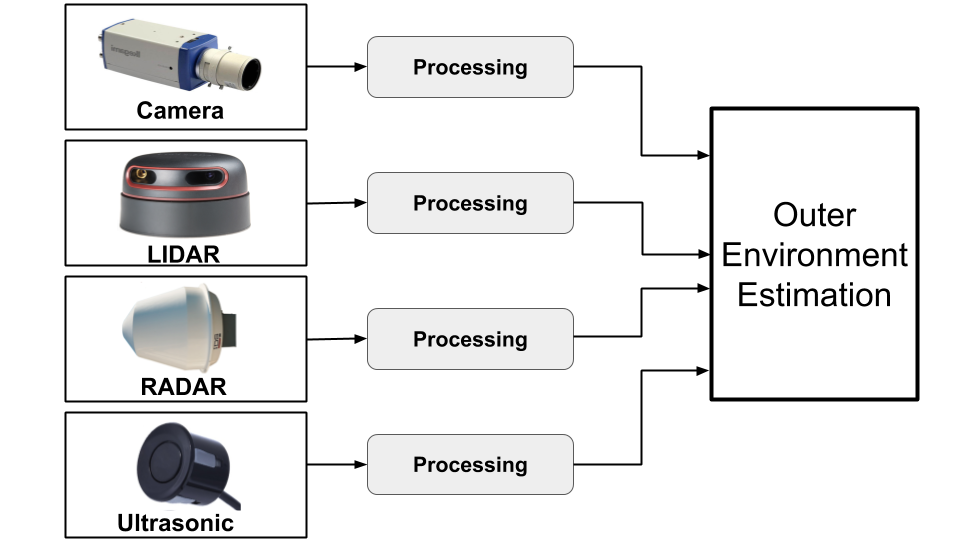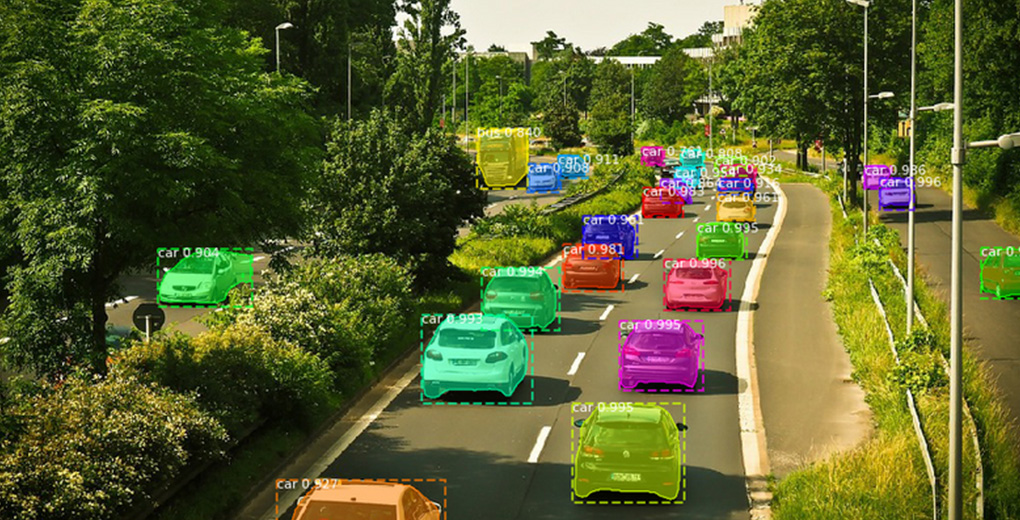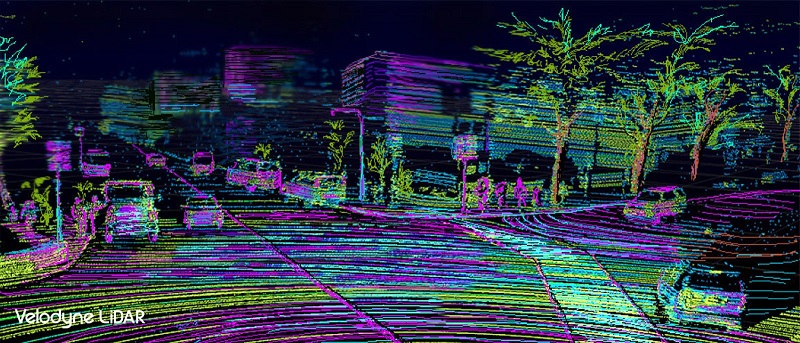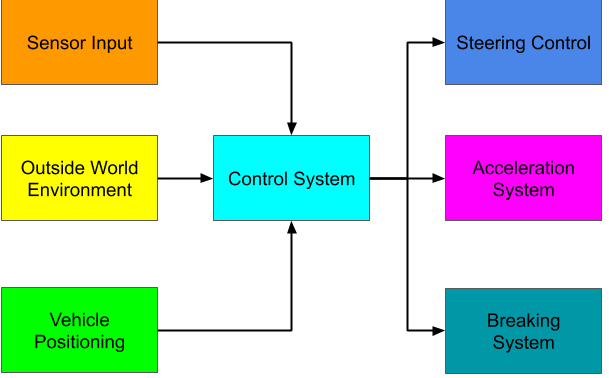Major technology companies such as Google, Apple, Ford, Audi, Tesla and spending a lot of money in the development of self driving cars. Self driving cars will also reduce the transportation cost because humans are not required to drive autonomous vehicles.
According to data, 90% of road accidents are caused by human error. Autonomous vehicles will also reduce road accidents. But this does not mean autonomous vehicles will reduce accidents to zero. In recent times we have seen news about self driving cars causing accidents. Lot of testing is going on to improve autonomous vehicles. In this article we will discuss what are self driving cars and how they work.
Click this link to know about automatic Transmission system used in autonomous cars
What are Self Driving Cars?
Self Driving cars do not require a human driver to reach from one location to another. They can recognize traffic lights, road signs, detect obstacles, predict the behavior of other drivers and act accordingly.
Lyft and Uber are developing Self driving cars that can pick passengers and drop them at their destination. General motor and tesla are also testing self driving trucks.
Self Driving Car (Autonomous Vehicle) Levels
According to the extent of automation, Society of Automotive Engineers (SAE) has classified Autonomous vehicles in the following six levels.
Level-0 : Most of the cars on the road are Level-0 autonomous vehicles. These vehicles have no automation. Vehicles equipped with proximity rear sensor, rear camera and cruise control come in level-0 category.
Level-1 : Level-1 autonomous vehicles can control by itself according to environmental sensor data. They have features such as a lane assistant system and radar based cruise control.
Level-2 : Level-2 autonomous vehicles can steer the car and change acceleration. These autonomous vehicles have features such as Changing a lane during cruise control and self parking etc. But in this Driver needs to be always attentive. E.g. Mersdize Benz Intelligent drive forward thinking system.
Level-3 : Level-3 self-driving cars are capable of self drive on certain roads. But in tricky situations humans have to instantly take over. Therefore they don’t offer much advantage to the driver.
Level-4 : Level-4 self-driving vehicles are smart enough to handle tricky situations. They can operate without any driver inside but limited to some locations only. Whereas in other locations they utilize human drivers as fail safe. Google Waymo is Level 4 Autonomous vehicle. Whereas Ford is going to launch Level 4 autonomous vehicles by 2021.
Level-5 : Level-5 autonomous vehicles are driverless vehicles in true sense. They can completely control by itself and any intervention from the driver is not required.
Benefits of Self Driving Cars
Following are the advantages of self-driving cars compared to conventional vehicles:
- According to the national highway safety administration 90% of road accidents are caused by human error. Self driving cars will help in reducing these accidents.
- Reduced Road Congestion.
- Reduced Pollution
- Self driving cars will reduce the transportation cost as no human will be involved.
- More convenience for children and old people.
How Self Driving Cars Work?
Self Driving cars can recognize traffic lights, road signs, detect obstacles, predict the behavior of other drivers and control the vehicle accordingly. Autonomous vehicles utilizes following major components to move from one location to another:
- Autonomous Vehicle Vision using Sensors
- Vehicle Localization and Positioning
- Trajectory and Path Planning
- Vehicle Control
Autonomous Vehicle Vision : Array of Sensors

Following vision sensors are used to create outside environment for the autonomous vehicle. Different self driving car manufacturers are using different array of sensors to provide vision to autonomous Vehicles. Click this link to know various types of sensors.
- Camera
- LiDAR
- Radar
- Ultrasonic Sensors
Camera : Computer Vision
Like the way humans use eyes to see the outside world and take decisions accordingly. Self driving cars utilize computer vision to see the road. Cameras along with other array of sensors are used to create self driving car outer environment.

Unlikely to human eyes which have only front vision. Autonomous vehicles have an array of cameras all around them. Camera images are processed by deep learning algorithms. It helps in:
- Object detection and classification
- Detecting other vehicles
- Obstacle Detection
- Understanding Traffic Lights
- Recognize lanes and sign board
- Other Driver behavior Estimation
LIDAR : Light Detection and Ranging
LIDAR is a laser based radar system. It works similar to radar but instead of radio waves it utilizes light waves that are reflected by objects. In this way point clouds for the outside environment are created. This allows self driving car to detect far objects.

Limitation of LIDAR is it can not recognize road signs or can not differentiate between a stone or polythene bag.
Some companies such as Tesla are making self driving cars without LIDAR. Because they are very expensive sensors. LIDAR for self driving car cost approximately $7000 to $10,000. Tesla’s system is based on monocular forward-looking camera technology from Mobileye.
RADAR
RADAR is used in self-driving cars to determine distance and speed of the moving object. But they have limitations in recognizing objects and detecting smaller objects. For example, radar will consider a polythene and stone the same object, but it can tell how far they are and at what speed they are moving.
Ultrasonic Sensors
They are used to detect objects at relatively smaller distances. For example Ultrasonic sensors are used in self driving car for parking.
Vehicle Localization and Mapping
After understanding the world around the self driving car. Next step is to determine vehicle position. GPS technology is used to determine autonomous vehicle position. But GPS has following problems:
- GPS have an accuracy in the range of 5 to 10 meters. Which is very high for an autonomous vehicle.
- GPS do not work in tunnels
Therefore GPS, Wheel odometry, digital maps and information from cameras are used to predict vehicle position within a few centimeters. Digital maps contain information about landmarks, road signs etc.
Vehicle speed, its wheel diameter is also used to predict vehicle position more accurately.
Trajectory and Path Planning
After we have autonomous vehicles in an accurate position in the outside world. Next step is planning a vehicle optimized path from one position to another.
This process involves predicting the behavior of other vehicles and plan accordingly. In the future when there will be lot of self driving vehicles on the road. These self driving cars will communicate with each other and will take decisions accordingly.
Vehicle Control

To control autonomous vehicles we need to turn the steering wheel, control vehicle acceleration and apply brakes. Self driving cars make these decisions based on the outer environment. PID (Proportional Integral and Derivative) Controls are used to control the vehicle.
To sum up, Self driving cars will bring the next revolution in the transportation sector. It will help in reducing fatal road accidents and reduce congestion on the road.
We will keep adding more information on the working of self driving vehicles. Please add your suggestions, comments or questions in the comment box.

Add a Comment